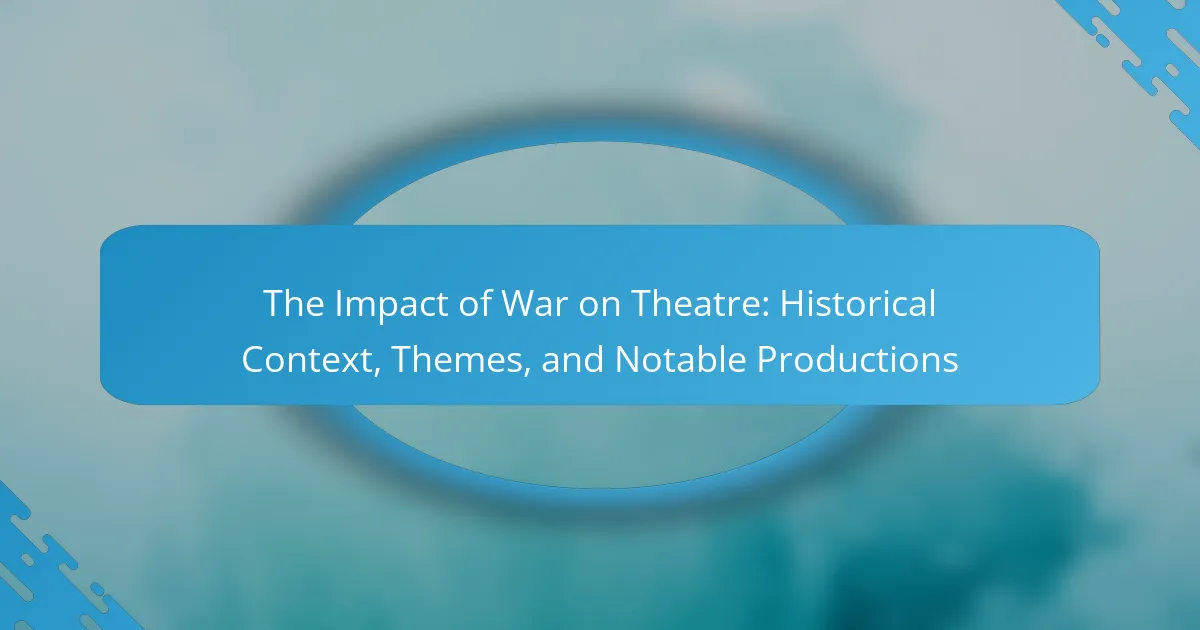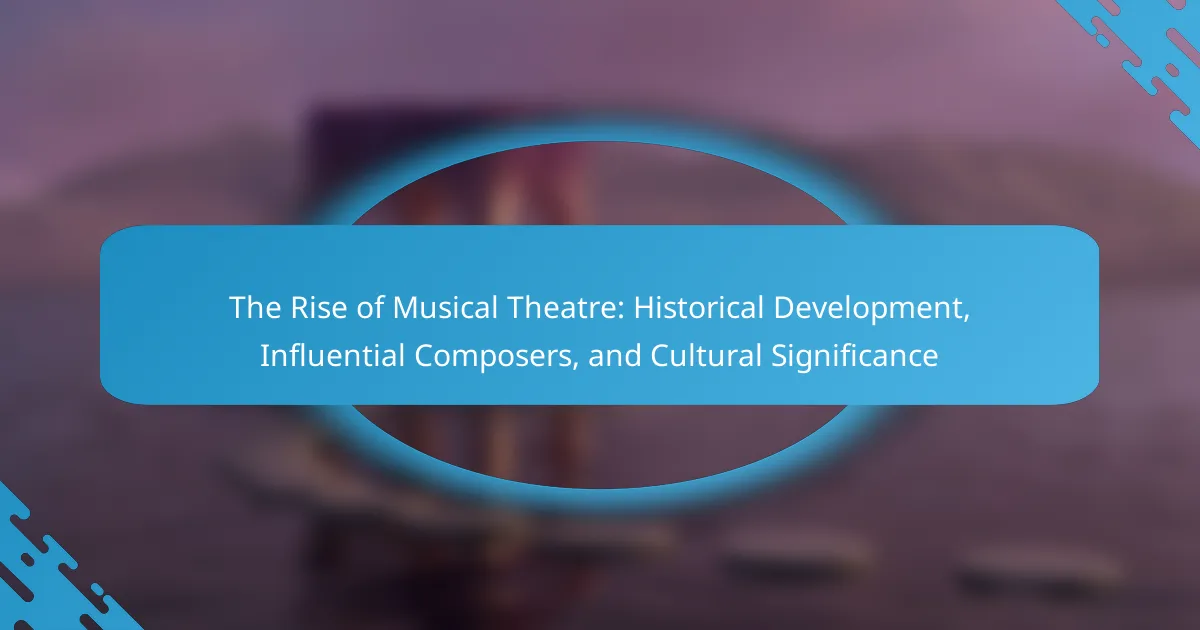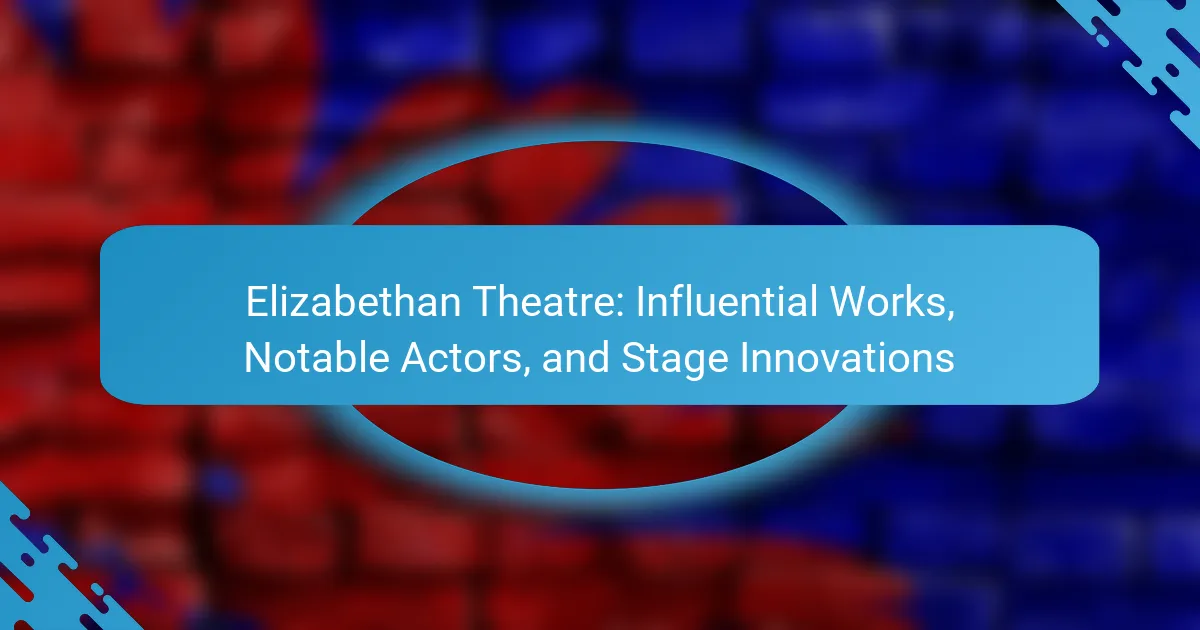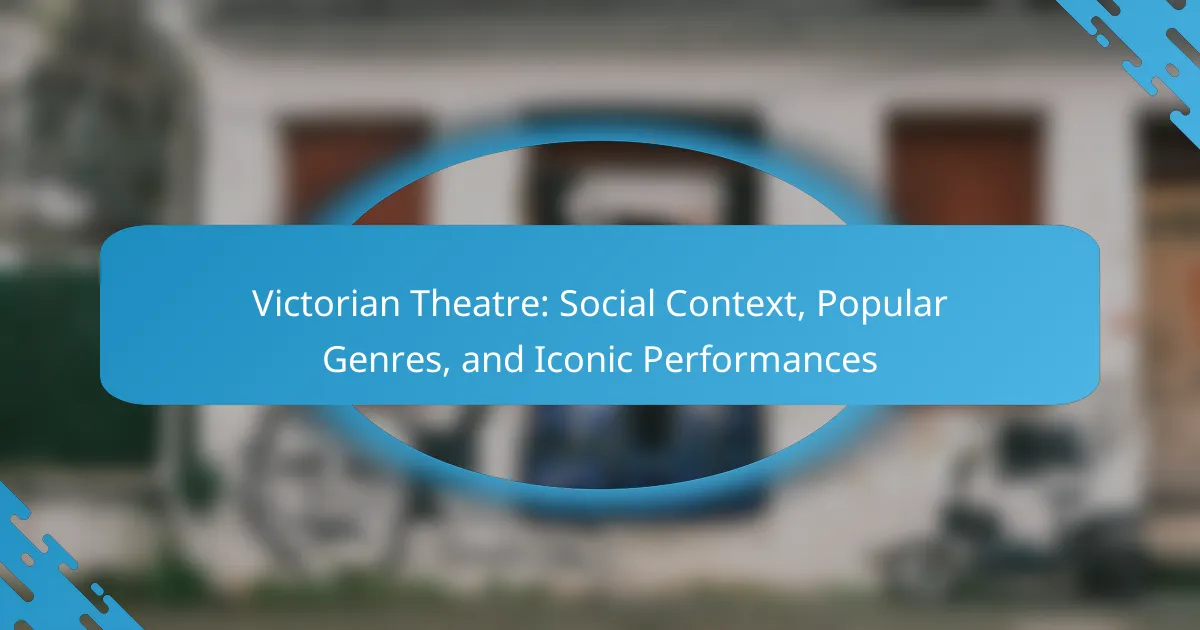Postmodern Theatre is defined by its departure from traditional narrative structures, embracing fragmentation, non-linear storytelling, and self-referentiality. Key productions such as “Waiting for Godot” by Samuel Beckett and “The Wooster Group’s Hamlet” exemplify these characteristics, utilizing absurdism and multimedia elements respectively. Thematic explorations in Postmodern Theatre often focus on identity, reality, and the nature of art, frequently incorporating intertextuality and parody to challenge established norms. This article examines the defining features of Postmodern Theatre, highlights significant productions, and delves into the thematic complexities that reflect contemporary society.
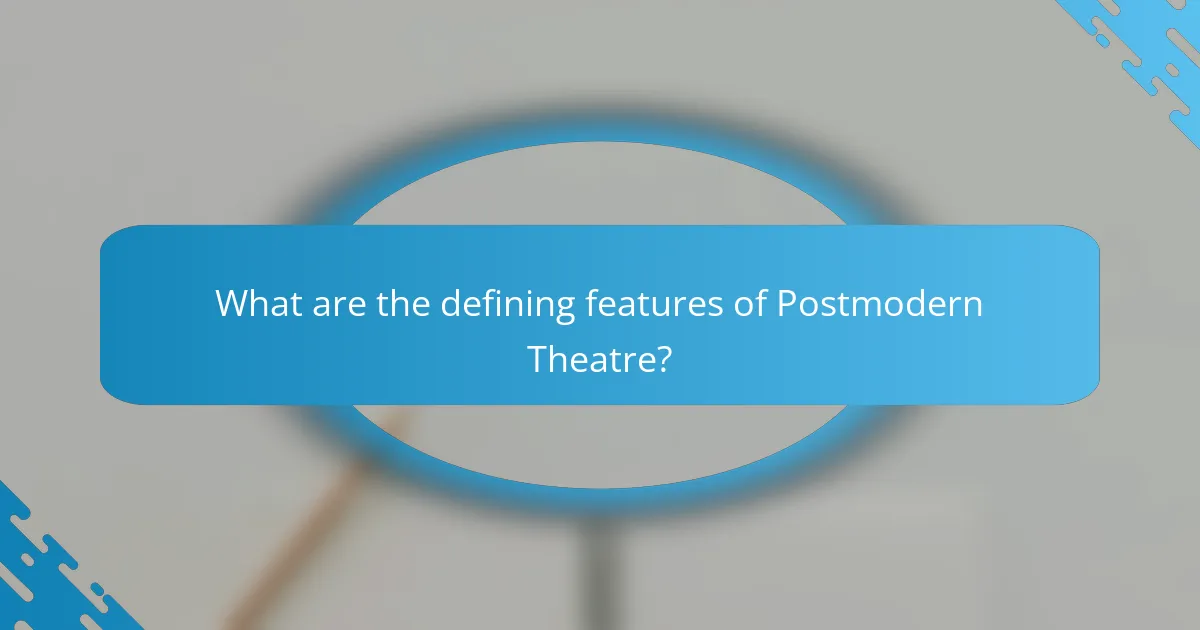
What are the defining features of Postmodern Theatre?
Postmodern Theatre is characterized by its rejection of traditional narrative structures and conventions. It often employs fragmentation, mixing of genres, and self-referentiality. The use of pastiche is common, blending various styles and forms. Intertextuality plays a significant role, referencing other works within the performance. Audience participation is frequently encouraged, breaking the fourth wall. Non-linear storytelling is a hallmark, creating multiple interpretations. Thematic exploration often includes identity, reality, and the nature of art itself. These features reflect the complexities of contemporary society and challenge established norms in theatre.
How does Postmodern Theatre differ from Modern Theatre?
Postmodern Theatre differs from Modern Theatre primarily in its approach to narrative and structure. Modern Theatre often follows a linear narrative and focuses on character development. In contrast, Postmodern Theatre embraces non-linear storytelling and fragmented narratives. Modern Theatre typically aims for realism and emotional depth. Postmodern Theatre often incorporates irony, parody, and pastiche, challenging traditional forms.
Additionally, Modern Theatre tends to reflect societal issues in a straightforward manner. Postmodern Theatre, however, plays with audience expectations and blurs the boundaries between high and low culture. This shift is evident in works by playwrights like Samuel Beckett and Tom Stoppard, who utilize absurdity and meta-theatrical elements. The emphasis on deconstruction in Postmodern Theatre marks a significant departure from the cohesive narratives of Modern Theatre.
What are the key characteristics that define Postmodern Theatre?
Postmodern Theatre is characterized by fragmentation, intertextuality, and a questioning of reality. Fragmentation refers to non-linear narratives that disrupt traditional storytelling. Intertextuality involves referencing other texts and media within performances. This theatre form often blurs the lines between high and low culture. It challenges the notion of a single, authoritative interpretation of a text. Additionally, Postmodern Theatre frequently incorporates elements of parody and pastiche. These characteristics reflect a skepticism towards grand narratives and ideologies. Prominent examples include productions by companies like The Wooster Group and works by playwrights such as Sarah Kane.
In what ways does Postmodern Theatre challenge traditional narratives?
Postmodern Theatre challenges traditional narratives through fragmentation, intertextuality, and the blurring of boundaries. Fragmentation disrupts linear storytelling. It often presents disjointed scenes that reflect chaos and complexity in modern life. Intertextuality involves referencing other works, creating a dialogue between texts. This technique undermines the notion of originality in storytelling. The blurring of boundaries occurs between genres, forms, and reality. Postmodern plays may mix comedy with tragedy or incorporate multimedia elements. These methods create a self-reflexive experience for the audience. They question the authority of the playwright and the reliability of narratives. Prominent examples include works by playwrights like Samuel Beckett and David Mamet. Their plays exemplify these techniques, showcasing the departure from conventional storytelling.
What techniques are commonly used in Postmodern Theatre?
Postmodern Theatre commonly employs techniques such as fragmentation, pastiche, and intertextuality. Fragmentation breaks linear narratives into non-sequential scenes. This reflects the chaos of contemporary life. Pastiche combines various styles and genres, celebrating diversity in art forms. Intertextuality references other texts, creating layered meanings. These techniques challenge traditional storytelling methods. They invite audience participation and interpretation. The use of irony and parody is also prevalent. These elements highlight the absurdity of modern existence.
How do elements like fragmentation and non-linear storytelling manifest in Postmodern Theatre?
Fragmentation and non-linear storytelling are central elements in Postmodern Theatre. Fragmentation disrupts traditional narrative structures, presenting disjointed scenes and characters. This approach reflects the chaotic nature of contemporary life. Non-linear storytelling allows for multiple timelines and perspectives, challenging the audience’s perception of time. Productions like “Waiting for Godot” by Samuel Beckett exemplify these techniques. They emphasize existential themes through fragmented dialogue and non-linear progression. These elements encourage viewers to engage actively with the material. They invite interpretation rather than providing straightforward narratives. Overall, fragmentation and non-linear storytelling are vital in shaping the Postmodern Theatre experience.
What role does intertextuality play in Postmodern Theatre productions?
Intertextuality plays a crucial role in Postmodern Theatre productions. It allows for the blending of various texts and cultural references. This technique creates layered meanings and challenges traditional narratives. Postmodern Theatre often subverts expectations through pastiche and parody. For instance, productions may incorporate elements from classic plays while reinterpreting them. This approach not only critiques original works but also engages audiences in a dialogue about meaning. The use of intertextuality reflects the fragmented nature of contemporary society. It emphasizes the idea that texts are interconnected and meaning is constructed through these relationships.
Why is audience participation significant in Postmodern Theatre?
Audience participation is significant in Postmodern Theatre because it breaks the traditional barrier between performers and spectators. This interaction fosters a sense of community and shared experience. Postmodern Theatre often challenges conventional narratives and structures. By involving the audience, it encourages active engagement and critical thinking. This approach reflects the postmodern emphasis on fragmentation and multiplicity in art. Historical examples include immersive productions that invite audience members to influence the outcome. Such techniques can enhance emotional impact and personal connection to the performance. Overall, audience participation redefines the role of the spectator in the theatrical experience.
How does audience engagement alter the experience of Postmodern Theatre?
Audience engagement significantly alters the experience of Postmodern Theatre. It transforms passive spectators into active participants. This interaction fosters a sense of immediacy and personal connection to the performance. Postmodern Theatre often blurs the lines between performer and audience. This encourages unique interpretations and responses from viewers. Studies show that engaged audiences report heightened emotional reactions. They often feel a deeper understanding of the themes presented. For instance, immersive productions invite audiences to physically navigate the space. This involvement can lead to a more profound appreciation of the narrative. The dynamic relationship between performers and the audience shapes the overall experience.
What are some examples of interactive techniques used in Postmodern Theatre?
Some examples of interactive techniques used in Postmodern Theatre include audience participation, breaking the fourth wall, and immersive environments. Audience participation involves inviting spectators to engage directly with the performance. This can manifest as asking questions or involving them in scenes. Breaking the fourth wall occurs when actors acknowledge the audience’s presence, fostering a connection. Immersive environments create settings where the audience moves through the space, interacting with performers and elements of the production. These techniques enhance engagement and challenge traditional theatre boundaries. Notable productions like “Sleep No More” exemplify these interactive methods, allowing viewers to explore the narrative at their own pace.
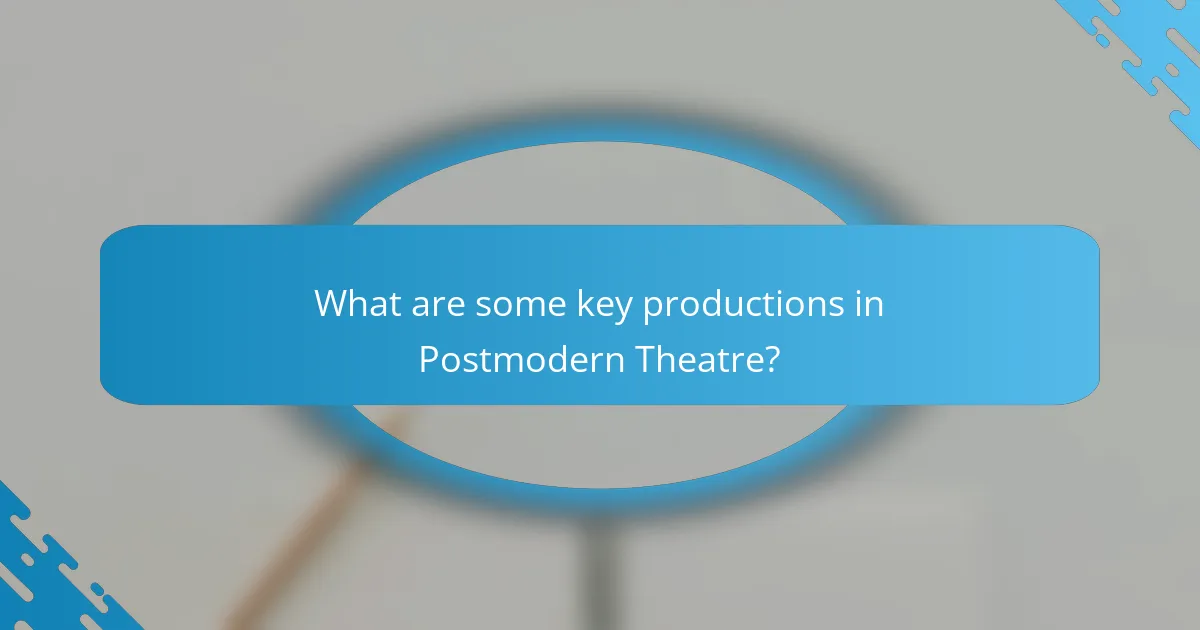
What are some key productions in Postmodern Theatre?
Key productions in Postmodern Theatre include “Waiting for Godot” by Samuel Beckett and “The Wooster Group’s Hamlet.” “Waiting for Godot” exemplifies absurdism and nonlinear narrative. It challenges traditional plot structures and character development. “The Wooster Group’s Hamlet” merges multimedia elements with Shakespeare’s text. This production highlights the interplay between technology and performance. Other notable works are “The Bald Soprano” by Eugène Ionesco and “Top Girls” by Caryl Churchill. “The Bald Soprano” employs nonsensical dialogue to critique social norms. “Top Girls” explores feminism and societal expectations through fragmented storytelling. These productions collectively reflect the diverse characteristics of Postmodern Theatre.
Which notable plays exemplify Postmodern Theatre?
Notable plays that exemplify Postmodern Theatre include “Waiting for Godot” by Samuel Beckett. This play highlights the absurdity of existence and the nonlinear nature of time. Another significant work is “Topdog/Underdog” by Suzan-Lori Parks. It explores identity and race through fragmented narratives. “The Wooster Group’s” productions also embody postmodern techniques, often blending media and styles. “The Bald Soprano” by Eugène Ionesco exemplifies the use of nonsensical dialogue to challenge traditional storytelling. These plays showcase the key characteristics of Postmodern Theatre, such as intertextuality and self-referentiality.
What themes are explored in these key Postmodern Theatre productions?
Key themes explored in Postmodern Theatre productions include fragmentation, identity, and meta-theatricality. Fragmentation reflects the disjointed narratives often present in these works. Identity is frequently examined through characters that challenge traditional roles and societal norms. Meta-theatricality involves self-referential elements that highlight the nature of theatre itself. Additionally, themes of absurdity and existentialism are common, questioning the meaning of life and reality. These themes are evident in notable productions like “Waiting for Godot” and “The Bald Soprano,” which illustrate the complexities of human experience.
How have these productions influenced the evolution of theatre?
Postmodern theatre productions have significantly influenced the evolution of theatre by challenging traditional narratives and structures. They introduced non-linear storytelling and fragmented narratives, which reshaped audience expectations. Productions like “Waiting for Godot” by Samuel Beckett emphasized absurdism, altering the perception of plot and character development. The use of multimedia elements in postmodern works has expanded the theatrical experience beyond mere dialogue. Additionally, the incorporation of diverse voices and perspectives has fostered inclusivity in storytelling. These changes reflect societal complexities and the questioning of authority in art. Overall, postmodern theatre has redefined the boundaries of performance, encouraging innovative approaches to storytelling.
What are the contributions of significant playwrights to Postmodern Theatre?
Significant playwrights have profoundly influenced Postmodern Theatre through their innovative techniques and thematic explorations. Samuel Beckett’s works, such as “Waiting for Godot,” challenged traditional narrative structures and introduced absurdism. David Mamet’s dialogue-driven plays, like “American Buffalo,” emphasized fragmented communication and realism. Tom Stoppard’s “Rosencrantz and Guildenstern Are Dead” blurred the lines between reality and fiction, questioning authorship and existence. Caryl Churchill’s “Top Girls” utilized non-linear storytelling and feminist themes to critique societal norms. These contributions reflect a departure from modernist conventions, embracing paradox, playfulness, and a questioning of meaning in a post-industrial society.
Who are the influential playwrights associated with Postmodern Theatre?
Influential playwrights associated with Postmodern Theatre include Samuel Beckett, David Mamet, and Tom Stoppard. Samuel Beckett’s work often explores existential themes and the absurdity of human experience. His play “Waiting for Godot” is a seminal example of postmodernism. David Mamet is known for his unique dialogue style and exploration of power dynamics. His play “Glengarry Glen Ross” showcases these themes effectively. Tom Stoppard combines philosophical exploration with wit, as seen in “Rosencrantz and Guildenstern Are Dead.” These playwrights have significantly shaped the landscape of Postmodern Theatre through their innovative approaches and thematic depth.
What unique perspectives do these playwrights bring to the genre?
Postmodern playwrights bring diverse and innovative perspectives to the genre. They often challenge traditional narrative structures. Their works frequently blend different genres and styles. This creates a unique theatrical experience. Playwrights like Sarah Kane explore themes of violence and mental health. They reflect contemporary societal issues through fragmented storytelling. Others, like Tom Stoppard, incorporate metafictional elements. This self-referential approach invites audiences to question reality. Overall, these playwrights redefine audience engagement and interpretation in theatre.
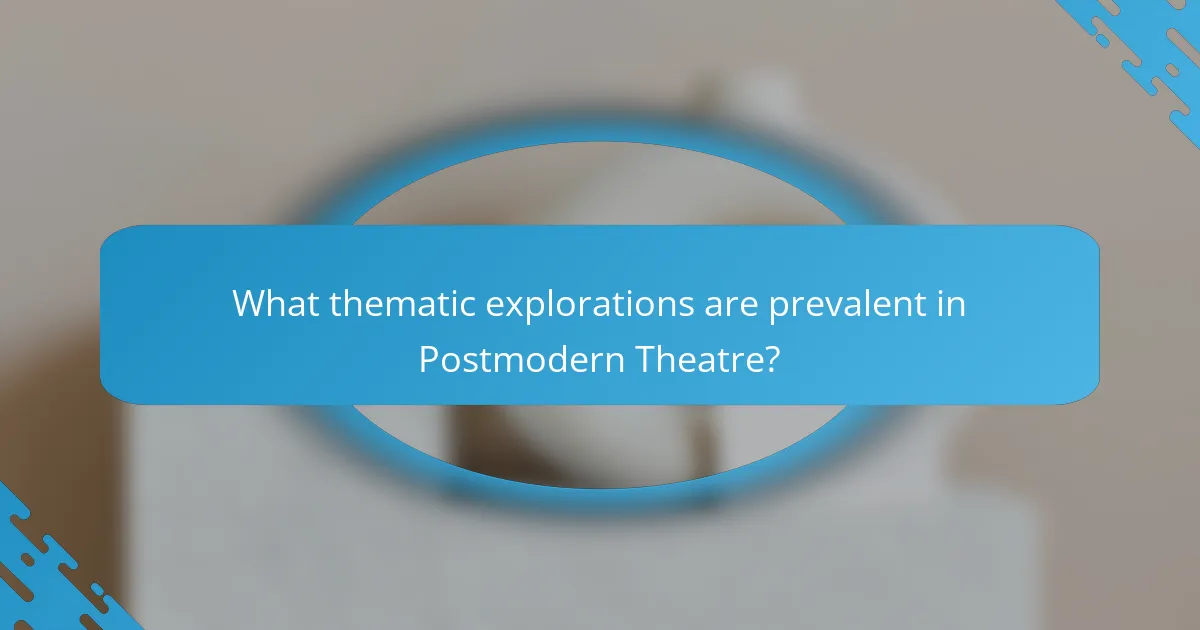
What thematic explorations are prevalent in Postmodern Theatre?
Postmodern Theatre explores themes such as fragmentation, identity, and the blurring of reality and illusion. Fragmentation manifests through non-linear narratives and disjointed scenes. Identity is often portrayed as fluid, challenging traditional notions of self. The blurring of reality and illusion creates a sense of uncertainty for the audience. Additionally, intertextuality is a common theme, referencing other works and cultural texts. This approach questions the nature of originality and authorship. The use of parody and pastiche reflects a critical stance towards established genres. These thematic explorations reflect the complexities of contemporary life and art.
How does Postmodern Theatre address issues of identity and culture?
Postmodern Theatre addresses issues of identity and culture through fragmentation and intertextuality. It often presents multiple perspectives on identity, reflecting the complexity of modern life. The use of non-linear narratives allows for diverse cultural voices to emerge. Characters frequently challenge traditional identity constructs, showcasing fluidity in gender and ethnicity. Additionally, Postmodern Theatre incorporates various cultural references, blending high and low art forms. This eclectic approach highlights the interplay between different cultural contexts. Productions like “The Vagina Monologues” and “Topdog/Underdog” exemplify these themes. They provoke discussions about personal and societal identities. Thus, Postmodern Theatre serves as a platform for exploring the multiplicity of identity and cultural dynamics.
What role does social commentary play in Postmodern Theatre narratives?
Social commentary plays a crucial role in Postmodern Theatre narratives. It serves as a vehicle for critique of contemporary society. Postmodern Theatre often challenges traditional narratives and structures. This genre utilizes irony and absurdity to reflect societal issues. For instance, plays like “Waiting for Godot” by Samuel Beckett illustrate existential dilemmas. They highlight the absurdity of human existence and societal norms. Additionally, works by David Mamet expose the complexities of language and power dynamics. Such narratives provoke audiences to question their realities. The blend of humor and discomfort in these works amplifies their social critique.
How do Postmodern plays reflect contemporary societal challenges?
Postmodern plays reflect contemporary societal challenges by deconstructing traditional narratives and questioning established norms. These plays often address issues such as identity, consumerism, and technology’s impact on human relationships. For instance, works like “Waiting for Godot” by Samuel Beckett highlight existential themes and the absurdity of modern life. They challenge audiences to confront the fragmentation of meaning in a rapidly changing world. Additionally, postmodern theatre uses non-linear storytelling and mixed media to mirror the chaos of contemporary society. This approach emphasizes the complexity of individual experiences in a globalized context. Through irony and parody, these plays critique social and political constructs, encouraging reflection on current issues.
What philosophical questions does Postmodern Theatre raise?
Postmodern Theatre raises questions about the nature of reality and truth. It challenges the idea of a single narrative or perspective. This form of theatre often questions the reliability of language and representation. It explores the role of the audience in interpreting meaning. Postmodern Theatre also examines the fluidity of identity and self. It prompts discussions on the boundaries between high and low culture. Additionally, it interrogates the concept of authorship and originality in art. These questions reflect broader philosophical inquiries about existence and perception.
How does Postmodern Theatre engage with concepts of reality and truth?
Postmodern Theatre engages with concepts of reality and truth by challenging traditional narratives and structures. It often employs techniques such as fragmentation, pastiche, and intertextuality. These methods create a sense of disorientation regarding what is real. The use of meta-theatrical elements blurs the line between performance and reality. Characters may acknowledge their fictional nature, further questioning authenticity. Additionally, Postmodern Theatre often presents multiple perspectives, undermining a singular truth. Works like “Waiting for Godot” by Samuel Beckett exemplify this approach. The play’s circular structure and ambiguous meaning illustrate the complexities of truth. This engagement reflects broader philosophical inquiries into reality and perception.
What existential themes are explored in Postmodern Theatre works?
Postmodern Theatre explores several existential themes, including the absurdity of existence, fragmentation of identity, and the search for meaning. The absurdity of existence is often depicted through characters facing meaningless situations. Fragmentation of identity highlights the disintegration of the self in a chaotic world. The search for meaning reflects characters grappling with existential questions. Works by playwrights like Samuel Beckett and Harold Pinter exemplify these themes. For instance, Beckett’s “Waiting for Godot” illustrates the absurdity and waiting without purpose. Pinter’s plays often showcase fragmented communication, emphasizing identity crises. These themes resonate with the postmodern condition, reflecting societal disillusionment.
What practical insights can be gained from studying Postmodern Theatre?
Studying Postmodern Theatre provides insights into the deconstruction of traditional narratives. It emphasizes the blending of genres and styles, showcasing how boundaries in art can be transcended. This approach encourages creative freedom and experimentation in performance.
Postmodern Theatre often challenges societal norms and conventions. It invites audiences to question reality and perception through its fragmented storytelling. The use of pastiche and irony is prevalent, allowing for multiple interpretations.
Additionally, it highlights the importance of context in understanding a performance. The interplay between text, performance, and audience engagement becomes crucial. This understanding can inform contemporary theatrical practices and educational methodologies.
Historical examples, such as the works of playwrights like Samuel Beckett and Tony Kushner, illustrate these principles effectively. Their contributions demonstrate the evolution of theatre in response to cultural shifts.
How can understanding Postmodern Theatre enhance theatrical productions today?
Understanding Postmodern Theatre can enhance theatrical productions today by encouraging innovation and experimentation. Postmodern Theatre challenges traditional narratives and structures. It embraces fragmentation, non-linear storytelling, and intertextuality. This approach allows for diverse interpretations and audience engagement. Productions can incorporate multimedia elements and unconventional staging. This flexibility fosters creativity among directors and actors. Historical examples, such as “Waiting for Godot” by Samuel Beckett, illustrate these principles. Such works have influenced contemporary playwrights and directors. By studying Postmodern Theatre, artists can push boundaries and redefine theatrical experiences.
What lessons from Postmodern Theatre can be applied to modern storytelling techniques?
Postmodern Theatre teaches the importance of breaking traditional narrative structures in modern storytelling. This includes non-linear timelines, which create a more dynamic experience. Additionally, the use of metafiction encourages self-awareness in narratives. Characters can become aware of their fictional nature, adding depth. Intertextuality allows stories to reference and build upon other works. This enriches the narrative landscape and engages audiences more deeply. Fragmentation of plot and character enhances complexity and realism. Finally, embracing ambiguity invites diverse interpretations, fostering richer discussions among audiences. These elements collectively influence contemporary storytelling techniques across various media.
Postmodern Theatre is characterized by its rejection of traditional narrative structures, employing techniques such as fragmentation, intertextuality, and audience participation. This article explores the defining features of Postmodern Theatre, highlighting its differences from Modern Theatre and examining key productions and influential playwrights. Themes prevalent in Postmodern works, including identity, reality, and the absurdity of existence, are discussed, alongside the impact of these productions on contemporary storytelling and theatrical practices. The article provides insights into how Postmodern Theatre challenges established norms and reflects the complexities of modern society.
